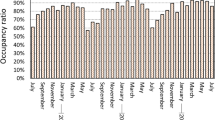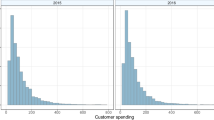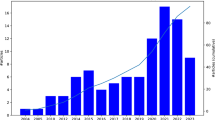Abstract
Standard revenue management (RM) methods typically work with an integrated forecast of demand and customer choice at booking class level and then maximize revenue by optimally controlling class availability. We show that the structure of the RM problem can be decomposed into two sub-problems: capacity control and price optimization for incoming customer requests. For capacity control in practice often bid prices, the dual variables to the capacity constraints, are used. Price optimization on the other hand needs forecasts of passengers’ willingness to pay. We propose to use two separate and tailored forecast models for both optimization tasks and discuss the advantages of this forecast separation. Furthermore, for the task of bid price calculation, we present a robust forecast model that is independent of booking classes and the actual control mechanism. It depends on historical booking data and bid prices only, but does not require historical fares and availabilities, which are often not available in good quality.








Similar content being viewed by others
Change history
28 February 2024
A Correction to this paper has been published: https://doi.org/10.1057/s41272-023-00464-4
Notes
Displacement costs are usually determined by solving a deterministic version of the network RM problem. A version based on network contribution forecasts is described in Deterministic network optimization section, Eq. (11).
References
Bartke, P. 2014. Demand estimation in airline revenue management. PhD thesis, Freie Universität Berlin, Germany.
Belobaba, P., Odoni, A., and Barnhart, C., editors. 2009. The global airline industry. New York: Wiley.
Cleophas, C., M. Frank, and N. Kliewer. 2009. Recent developments in demand forecasting for airline revenue management. International Journal of Revenue Management 3: 252–269.
Fiig, T., Hardling, R., Pölt, S., and Hopperstad, C. 2014. Demand forecasting and measuring forecast accuracy in general fare structures. Journal of Revenue and Pricing Management 13.
Fiig, T., Isler, K., Hopperstad, C., and Belobaba, P. 2010. Optimization of mixed fare structures: Theory and applications. Journal of Revenue and Pricing Management 9.
Gerlach, M., and Frank, M. 2010. Introducing remate – revenue management simulation in practice. In AGIFORS Reservations and Yield Management Study Group Annual Meeting, New York.
Isler, K. 2011. Disentangling pricing and revenue management - again. In Key note speech at the 17th Annual PROS Revenue Management Conference, Chicago.
Meyer, F., Alder, C., and Kauermann, G. 2014. Estimating price elasticity. In AGIFORS Reservations and Yield Management Study Group Annual Meeting, Buenos Aires.
Talluri, K., and G. van Ryzin. 2004a. Revenue management under a general discrete choice model of consumer behavior. Management Science 50 (1): 15–33.
Talluri, K., and G. van Ryzin. 2004b. The theory and practice of revenue management. New York: Springer.
Westermann, D. 2013. The potential impact of iata’s new distribution capability (ndc) on revenue management and pricing. Journal of Revenue and Pricing Management 12 (6): 565–568.
Zhang, D., and R. Kallesen. 2008. Incorporating competitive price information into revenue management. Journal of Revenue and Pricing Management 7 (1): 17–26.
Author information
Authors and Affiliations
Corresponding author
Appendix
Appendix
Deterministic network optimization
With the notation from Network RM section, the deterministic network optimization problem is given by
In other words, we maximize total revenue while under the constrained that the expected number of booking for each resources does not exceed capacity. Different itineraries are only coupled through the capacity constraints, and the problem naturally lends itself to a dual decomposition approach: Let the row vector \(\pi = \left( {\pi_{1} , \ldots ,\pi_{m} } \right) \in {\mathbb{R}}^{m}\) be the dual variables or Lagrange multipliers associated to the capacity constraints, i.e., (deterministic) bid prices. The Lagrangian of Eq. (10) is given by
where in the second line the triple-sum is independent of capacity, while the last sum is independent of demand and the controls.
The Lagrange dual function is
where \(\mu_{k} = \mathop \sum \limits_{i = 0}^{m} \pi_{i} a_{i,k}\) is again the bid price for each itinerary k and
is the expected total network contribution function of itinerary k over the course of the booking horizon given itinerary bid price μ.
Optimal dual variables π for the original problem Eq. (10) can be computed by solving the Lagrange dual problem
This problem is non-linear but always convex by construction and hence can be solved efficiently. Given forecasts \(\hat{h}_{k} \left( {\tau ,\mu } \right)\) for the network contribution functions as described in Network RM section, one can therefore compute optimal deterministic displacement costs by solving
Rights and permissions
About this article
Cite this article
Rauch, J., Isler, K. & Poelt, S. Disentangling capacity control from price optimization. J Revenue Pricing Manag 17, 48–62 (2018). https://doi.org/10.1057/s41272-017-0118-9
Revised:
Published:
Issue Date:
DOI: https://doi.org/10.1057/s41272-017-0118-9




